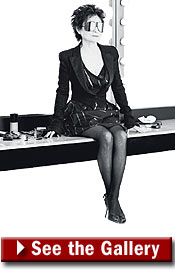
Yoko Ono is darting around her apartment in the Dakota on a bitterly cold and dark afternoon getting ready for a trip. The extra-generous proportions of the space—soaring ceilings with doorways just beneath—only emphasize her tininess, as she dashes across the wall-to-wall white carpeting wearing all black. With her little voice, smooth skin, and trim cargo pants, she seems a lot younger than her age, which is 71.
Ono’s style has evolved over time, influenced by her role as an artist, by her politics, but mostly, like a true icon, by her undeniably solid sense of herself. “I really communicate quite strongly with what I wear,” she says. When Yoko first came on the scene as a public figure, her hair was long and unkempt, her clothes loose, baggy, outrageous for the time. “It was such an improper thing to do, to grow your hair.” She giggles a childish giggle, still delighted at the naughtiness of her former self. It was after John Lennon was killed that she cut her hair into the henna’ed spikes she still wears, and adopted boxy men’s suits. “This was when people were all wearing nightgowns! I wasn’t wearing that,” she says. “I created a kind of outfit that made it easy for me to work. It’s a male society, and you have to not be totally different from them; you have to sort of use their vocabulary in some ways to deal with them.” She likes Armani, but not exclusively, and swears that she does love bright color—that if she’s in the mood for something taxi-cab yellow and feathered like a marabou, she’d be more than glad to put it on. But mostly she’s decided that the clearest message her wardrobe can give is one of neutrality. Like a lot of artists, she prefers to remain a blank slate, but she feels satisfied that the “work” she did in the sixties—all that jeans-wearing and bed-sitting—made it possible for us all to dress the way we do now, which is to say, however we want. “This age is a beautiful age,” she says. “Each one of us wearing something that we like to wear. We enjoy it, we show it, and it’s beautiful.”
She hasn’t yet decided what she’ll wear on this trip, to Oslo, Norway, where she will show her latest work at the Astrup Fearnley Museum of Modern Art. Called ONOCHORD, it consists of a lecture/performance by Ono and a group-participation exercise: the flashing of a rudimentary Morse-code version of “I Love You” using tiny penlights printed with the event’s name, date, and location. “It’s a race between people who destroy the Earth planet and people who heal the Earth planet,” she says, to explain the very “love is the answer” mission of the work. “Love is getting so scarce, and people are scared and frightened. We have to go back to trusting each other and loving each other. I really think I’m on a mission of making sure we heal this Earth.”